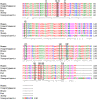GJB2 mutation spectrum in 2,063 Chinese patients with nonsyndromic hearing impairment
- PMID: 19366456
- PMCID: PMC2679712
- DOI: 10.1186/1479-5876-7-26
GJB2 mutation spectrum in 2,063 Chinese patients with nonsyndromic hearing impairment
Abstract
Background: Mutations in GJB2 are the most common molecular defects responsible for autosomal recessive nonsyndromic hearing impairment (NSHI). The mutation spectra of this gene vary among different ethnic groups.
Methods: In order to understand the spectrum and frequency of GJB2 mutations in the Chinese population, the coding region of the GJB2 gene from 2063 unrelated patients with NSHI was PCR amplified and sequenced.
Results: A total of 23 pathogenic mutations were identified. Among them, five (p.W3X, c.99delT, c.155_c.158delTCTG, c.512_c.513insAACG, and p.Y152X) are novel. Three hundred and seven patients carry two confirmed pathogenic mutations, including 178 homozygotes and 129 compound heterozygotes. One hundred twenty five patients carry only one mutant allele. Thus, GJB2 mutations account for 17.9% of the mutant alleles in 2063 NSHI patients. Overall, 92.6% (684/739) of the pathogenic mutations are frame-shift truncation or nonsense mutations. The four prevalent mutations; c.235delC, c.299_c.300delAT, c.176_c.191del16, and c.35delG, account for 88.0% of all mutantalleles identified. The frequency of GJB2 mutations (alleles) varies from 4% to 30.4% among different regions of China. It also varies among different sub-ethnic groups.
Conclusion: In some regions of China, testing of the three most common mutations can identify at least one GJB2 mutant allele in all patients. In other regions such as Tibet, the three most common mutations account for only 16% the GJB2 mutant alleles. Thus, in this region, sequencing of GJB2 would be recommended. In addition, the etiology of more than 80% of the mutant alleles for NSHI in China remains to be identified. Analysis of other NSHI related genes will be necessary.
Figures
Similar articles
-
Mutation analysis of common deafness-causing genes among 506 patients with nonsyndromic hearing loss from Wenzhou city, China.Int J Pediatr Otorhinolaryngol. 2019 Jul;122:185-190. doi: 10.1016/j.ijporl.2019.04.024. Epub 2019 Apr 21. Int J Pediatr Otorhinolaryngol. 2019. PMID: 31035178
-
Prevalence and range of GJB2 and SLC26A4 mutations in patients with autosomal recessive non‑syndromic hearing loss.Mol Med Rep. 2014 Jul;10(1):379-86. doi: 10.3892/mmr.2014.2148. Epub 2014 Apr 15. Mol Med Rep. 2014. PMID: 24737404
-
The prevalence of the 235delC GJB2 mutation in a Chinese deaf population.Genet Med. 2007 May;9(5):283-9. doi: 10.1097/gim.0b013e31804d2371. Genet Med. 2007. PMID: 17505205
-
Update of spectrum c.35delG and c.-23+1G>A mutations on the GJB2 gene in individuals with autosomal recessive nonsyndromic hearing loss.Ann Hum Genet. 2019 Jan;83(1):1-10. doi: 10.1111/ahg.12284. Epub 2018 Sep 3. Ann Hum Genet. 2019. PMID: 30175840 Review.
-
Systematic review and meta-analysis of pathogenic GJB2 variants in the Asian population.Int J Pediatr Otorhinolaryngol. 2025 Feb;189:112233. doi: 10.1016/j.ijporl.2025.112233. Epub 2025 Jan 15. Int J Pediatr Otorhinolaryngol. 2025. PMID: 39862573
Cited by
-
Genetic etiology study of four Chinese families with two nonsyndromic deaf children in succession by targeted next-generation sequencing.Mol Genet Genomic Med. 2021 Apr;9(4):e1634. doi: 10.1002/mgg3.1634. Epub 2021 Feb 27. Mol Genet Genomic Med. 2021. PMID: 33638616 Free PMC article.
-
Targeted next-generation sequencing in Uyghur families with non-syndromic sensorineural hearing loss.PLoS One. 2015 May 26;10(5):e0127879. doi: 10.1371/journal.pone.0127879. eCollection 2015. PLoS One. 2015. PMID: 26011067 Free PMC article.
-
Application of massively parallel sequencing to genetic diagnosis in multiplex families with idiopathic sensorineural hearing impairment.PLoS One. 2013;8(2):e57369. doi: 10.1371/journal.pone.0057369. Epub 2013 Feb 22. PLoS One. 2013. PMID: 23451214 Free PMC article.
-
Application of SNPscan in Genetic Screening for Common Hearing Loss Genes.PLoS One. 2016 Oct 28;11(10):e0165650. doi: 10.1371/journal.pone.0165650. eCollection 2016. PLoS One. 2016. PMID: 27792752 Free PMC article.
-
A novel compound heterozygous mutation in the GJB2 gene causing non-syndromic hearing loss in a family.Int J Mol Med. 2014 Feb;33(2):310-6. doi: 10.3892/ijmm.2013.1581. Epub 2013 Dec 9. Int J Mol Med. 2014. PMID: 24337325 Free PMC article.
References
-
- Cohen MM, Gorlin RJ. Epidemiology, etiology and genetic patterns. In: Gorlin RJ, Toriello HV, Cohen MM, editor. Hereditary hearing loss and its syndromes. Oxford: Academic Press; 1995. pp. 9–21.
Publication types
MeSH terms
Substances
Grants and funding
LinkOut - more resources
Full Text Sources
Medical



